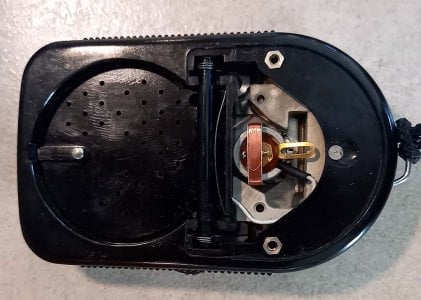Muggins
Junk magnet
Today I stupidly managed to drop my Euro Master, and the needle no longer moves - something has obviously come adrift and jammed it.
Given that the only UK repairer charges £189, and I could get something considerably more modern for that, has anyone ever opened one? I figure I have nothing to lose as it's toast anyway...
Given that the only UK repairer charges £189, and I could get something considerably more modern for that, has anyone ever opened one? I figure I have nothing to lose as it's toast anyway...
Out to Lunch
Menteur
For those not in the know, it's a light meter. Cheers, OtL
Retina43
Newbie
A UK repairer/restorer I’ve used. Weston Light Meter Repair and Restore Service
Chriscrawfordphoto
Real Men Shoot Film.
The needle has probably fallen off its bearings. Meters with moving needles are delicate.
Chriscrawfordphoto
Real Men Shoot Film.
A UK repairer/restorer I’ve used. Weston Light Meter Repair and Restore Service
That's the guy Muggins was saying was too expensive. I actually have a Weston Master V that I bought about 10 years ago from Ian Partridge. He had overhauled it and installed a new meter cell.
I wouldn't really recommend one of these today. As Muggins said, you can buy a much more accurate, capable, brand new meter today for what Ian charges to repair an old Weston. A modern meter will work in lower light, will be digital so it can take abuse without damage.
Muggins
Junk magnet
Fair point - consider it comeback for all the times people have utterly bemused me by talking about their ASBOS etc!For those not in the know, it's a light meter. Cheers, OtL
Yes, that's the chap. I've already got a Contax being fixed at a price I've only ever paid over once for a *new* camera (though this could be because I am a tightwad), I really can't justify spending that on a relic, might as well spend it on something new. I'm prepared to have a go at fixing something that's already toast (though I suppose it could go on ebay as spares/repair) as I can't make it function any worse than it already does! And, as anyone who collects old cameras does, I've accumulated a few that I can get by with in the mean time.That's the guy Muggins was saying was too expensive. I actually have a Weston Master V that I bought about 10 years ago from Ian Partridge. He had overhauled it and installed a new meter cell.
I wouldn't really recommend one of these today. As Muggins said, you can buy a much more accurate, capable, brand new meter today for what Ian charges to repair an old Weston. A modern meter will work in lower light, will be digital so it can take abuse without damage.
mnutzer
no title
My light meters have been idle for years, I'm satisfied with the TTL light meters built into cameras and for cameras without a light meter, a few exposure metering apps on the iPhone.
The only thing I sometimes miss is the light measurement with the cumbersome dome on the Weston Euro Master V.
The only thing I sometimes miss is the light measurement with the cumbersome dome on the Weston Euro Master V.
Coldkennels
Barnack-toting Brit.
The Euro Master is like the IV and V in that it has a mechanism to hold the needle in place, right?Today I stupidly managed to drop my Euro Master, and the needle no longer moves - something has obviously come adrift and jammed it.
Given that the only UK repairer charges £189, and I could get something considerably more modern for that, has anyone ever opened one? I figure I have nothing to lose as it's toast anyway...
I've repaired both IV and V meters in the past. That mechanism is almost always the problem - it's been ~10 years since I last looked into one, but it gets jammed and locks the needle in place permanently (until someone opens it up and reseats everything properly). It should be a simple fix, but Westons became more and more of a pain in the ass to open up as they went on.
On earlier models (II and III), you need to remove the plate on the back; there's two screws that don't have heads on them, so you need a way to turn them (pushing some rubber down onto them and turning it with your thumb is often enough). Once that plate is removed, you can access the actual screws that hold the two halves of the shell together (which are hidden under wax seals, so you'll need to scrape that out to find the screw heads). You should only need to remove the back half, as almost everything you need to access will be visible and reachable. Removing the front half exposes the needle, which is incredibly delicate - you want to do as much as possible to protect it, so I normally just leave the front half in place unless I really need to access something on the front of the mechanism.
I can't remember what's different on an IV or V, but I seem to remember it's the same basic layout for getting one open - and I don't think the Euro Master really changed much from the V, but I may be wrong.
Dralowid
Michael
In the past I have opened them up. The insides are pretty straightforward and if the needle has fallen out of its bearing the course of action is obvious and may well prove to be successful. After all, you have nothing to lose. Not worth sending it off unless you have an emotional tie to yours...
Looking at the shelf I still have a II, a IV and two Vs. Don't ask why. They all give the same reading more or less.
Looking at the shelf I still have a II, a IV and two Vs. Don't ask why. They all give the same reading more or less.
R_a_feldman
Member
On earlier models (II and III), you need to remove the plate on the back; there's two screws that don't have heads on them, so you need a way to turn them (pushing some rubber down onto them and turning it with your thumb is often enough).
I have had success removing those screws (they have rounded tops and knurled sides) by pressing a slightly undersized aluminum tube (from K&S Metals) down on around the head. I could then turn the tube with vice grips.
When I had them out, I used a fine razor saw to cut a slot in the screws’ heads.
RichC
Well-known
They're pretty easy to work on. Not the kind of device where you take the back off and tiny parts fall or spring out never to be found again, or you need the manual dexterity of surgeon... As Chris C says, the needle/spring assembly has probably been knocked out of its mount or got stuck - a gentle poke ought to sort it. If it's bent or otherwise dead, it's fairly easy to transplant the gubbins from a second-hand one - the reason most don't work is a dead photo cell - but they're not soldered in, if I recall correctly, just held by pressure, so you can buy a dud one cheaply and reuse your working photo cell. There's websites showing this step by step.
If it ain't working you haven't much to lose! It'll only end up in a drawer with other dead tech...!
If it ain't working you haven't much to lose! It'll only end up in a drawer with other dead tech...!
Muggins
Junk magnet
Thanks, everyone, a winter project looms!
Coldkennels
Barnack-toting Brit.
@Muggins, I'd dropped one of my Weston IIs on a trip back in June and it's been on the shelf for a while; I spent this afternoon "repairing" it, and thought I'd take a couple of photos for you in the process - hopefully this helps. The Euro Master is a bit different, but if I'm right and it is just a repackaged V, the insides are very similar, from what I remember - there's only the bar that traps the needle which complicates things.
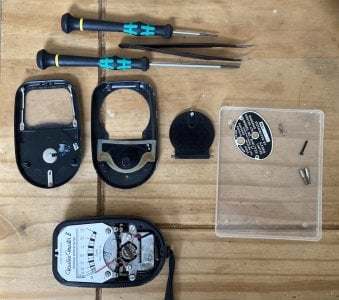
This photo represents the only tools and the only point you need to get to in order to solve any issues with Westons, in my experience. I didn't photograph the actual tear-down as there's not a lot to it: remove the nameplate on the back, remove the screws that are underneath, and lift the back from the bottom up; there's two angled metal rods holding the upper section in place that you need to slide the back off, as you can see here on the right:
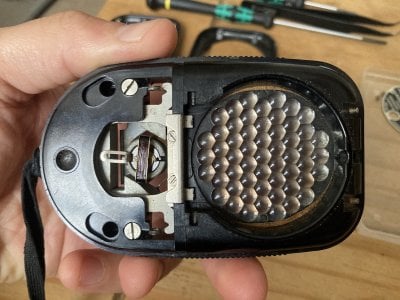
Take the "baffle flap" out, and there's just three screws holding the front in place; one at the top, and the two long ones you can see in the tray on the right in the first photo. Don't touch the wide slotted screws that are still in place in the second photo unless you have to go further in.
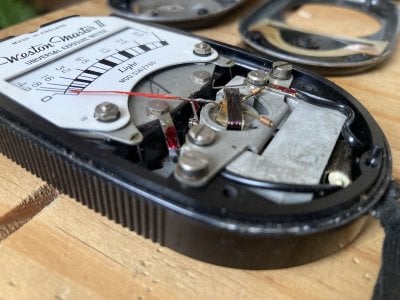
In this photo you can see both how delicate the needle is - don't put the meter face down without having the cover glass in place! - and the reason mine was jamming; there's a scrape line to the right of the solenoid. I presume the two arms with wraps of copper wire coming off the centre are weights to keep the mechanism balanced, and one of them had bent slightly downwards, meaning it was catching on the body of the meter. Bending it back up slightly allowed everything to move freely again.
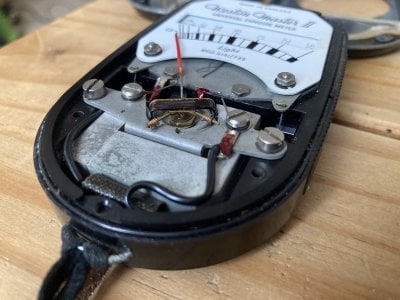
It's a really simple but delicate mechanism; when I first obtained this meter a few years back, the mechanism wasn't located properly, and that tiny spring in the centre was a bit of a mess. Some gentle coaxing got everything back to where it was supposed to be and it's been accurate across the range ever since.
A couple of words to the wise with regards to reassembly:
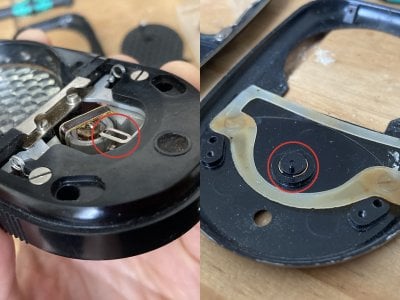
First, don't knock either of the circled components if you can help it. This is the zero-point adjustment, and the protrusion on the right has to locate inside the slot on the left. If you spin one out of place, it can be a real pain to get the two to line up correctly again. Don't ask me how I know that.

Finally, keep an eye on this little spring underneath the faceplate; it's what keeps the button for the film speed adjustment in place. First time I took a Weston apart I didn't realise it was supposed to be there until I reassembled the thing and something felt wrong. It was already lost in a shag-pile carpet at that point and I had to do a magnet sweep. Working over a tray and/or rubber mat is obviously best practice, but mistakes still happen!
This was maybe a five minute job at max. Westons are gloriously simple things to work on - much nicer than the Gossen Sixtar I've had on the shelf for over a year and keep meaning to repair - and I'm sure you'll be able to get yours back into shape with no stress at all. Good luck!

This photo represents the only tools and the only point you need to get to in order to solve any issues with Westons, in my experience. I didn't photograph the actual tear-down as there's not a lot to it: remove the nameplate on the back, remove the screws that are underneath, and lift the back from the bottom up; there's two angled metal rods holding the upper section in place that you need to slide the back off, as you can see here on the right:

Take the "baffle flap" out, and there's just three screws holding the front in place; one at the top, and the two long ones you can see in the tray on the right in the first photo. Don't touch the wide slotted screws that are still in place in the second photo unless you have to go further in.

In this photo you can see both how delicate the needle is - don't put the meter face down without having the cover glass in place! - and the reason mine was jamming; there's a scrape line to the right of the solenoid. I presume the two arms with wraps of copper wire coming off the centre are weights to keep the mechanism balanced, and one of them had bent slightly downwards, meaning it was catching on the body of the meter. Bending it back up slightly allowed everything to move freely again.

It's a really simple but delicate mechanism; when I first obtained this meter a few years back, the mechanism wasn't located properly, and that tiny spring in the centre was a bit of a mess. Some gentle coaxing got everything back to where it was supposed to be and it's been accurate across the range ever since.
A couple of words to the wise with regards to reassembly:

First, don't knock either of the circled components if you can help it. This is the zero-point adjustment, and the protrusion on the right has to locate inside the slot on the left. If you spin one out of place, it can be a real pain to get the two to line up correctly again. Don't ask me how I know that.

Finally, keep an eye on this little spring underneath the faceplate; it's what keeps the button for the film speed adjustment in place. First time I took a Weston apart I didn't realise it was supposed to be there until I reassembled the thing and something felt wrong. It was already lost in a shag-pile carpet at that point and I had to do a magnet sweep. Working over a tray and/or rubber mat is obviously best practice, but mistakes still happen!
This was maybe a five minute job at max. Westons are gloriously simple things to work on - much nicer than the Gossen Sixtar I've had on the shelf for over a year and keep meaning to repair - and I'm sure you'll be able to get yours back into shape with no stress at all. Good luck!
ChrisLivsey
Mentor
This may help as the later models differ in access:
Weston Master IV Disassembly & Notes (Page 1)
A look inside a Weston Master IV meter
www.jollinger.com
Coldkennels
Barnack-toting Brit.
Doesn't the Euro Master come apart the same way as the earlier ones? Looking at the photos on this listing, it looks much closer to the II and III: Weston Euro Master S4616 Universal Exposure Meter for sale online | eBayThis may help as the later models differ in access:
Weston Master IV Disassembly & Notes (Page 1)
A look inside a Weston Master IV meterwww.jollinger.com
x-ray
Mentor
They’re very nice meters. I found a really clean master V and put a Euromaster dial on it then had George at QLM rebuild it. Even though it was working he put a new cell in it and new grid. For lack of a better term I refer to the perforated flap that goes over the cell for low and high range. George also demagnetized the magnet in the meter movement. It works perfect and I carry it often.
An even better meter is the Westin Ranger 9. Again I found a clean working example and sent it to QLM whh by ere George Milton reworked, calibrated and converted it to a modern battery.
Neither meters were that cheap to refurb but there’s nothing on the market today comparable so I feel it was well worth the cost.
Unfortunately George retired and closed QLM and I’m not sure there’s a comparable service now.
An even better meter is the Westin Ranger 9. Again I found a clean working example and sent it to QLM whh by ere George Milton reworked, calibrated and converted it to a modern battery.
Neither meters were that cheap to refurb but there’s nothing on the market today comparable so I feel it was well worth the cost.
Unfortunately George retired and closed QLM and I’m not sure there’s a comparable service now.
ChrisLivsey
Mentor
Weston Euro-Master Exposure Meter Model S461.6 1973Doesn't the Euro Master come apart the same way as the earlier ones? Looking at the photos on this listing, it looks much closer to the II and III: Weston Euro Master S4616 Universal Exposure Meter for sale online | eBay
Last Model of Master made by Weston. Apart from the dial, identical to the Weston V. Dial is simplified and reverts back to the anchor shutter speeds and f numbers. Supports DIN and ASA speed ratings and EV system. Uses the linear relative brightness values as in the Weston V.
The Masters | John's Weston Meter Collection
A reference page for the Weston Master series of exposure meters. The Masters were Weston's most popular range and made in the United Kingdom as well as the United States of America.
 www.westonmeters.info
www.westonmeters.info
Muggins
Junk magnet
It looks as though the Euro-master is rear access too, there's no screw at the front, only a hole under a sticker that does not, as far as I can tell, have a screw lurking at the bottom of it.
Currently looking as though the toughest job might be getting a grip on the two screws/bolts with the almost flat, slot-less, head. Pencil rubber, possibly?
Currently looking as though the toughest job might be getting a grip on the two screws/bolts with the almost flat, slot-less, head. Pencil rubber, possibly?
Last edited:
Muggins
Junk magnet
Vince Lupo
Nobody's Mentor
As a result of your recommendation, I got myself a very nice Weston Ranger 9. $18 plus $6 shipping.They’re very nice meters. I found a really clean master V and put a Euromaster dial on it then had George at QLM rebuild it. Even though it was working he put a new cell in it and new grid. For lack of a better term I refer to the perforated flap that goes over the cell for low and high range. George also demagnetized the magnet in the meter movement. It works perfect and I carry it often.
An even better meter is the Westin Ranger 9. Again I found a clean working example and sent it to QLM whh by ere George Milton reworked, calibrated and converted it to a modern battery.
Neither meters were that cheap to refurb but there’s nothing on the market today comparable so I feel it was well worth the cost.
Unfortunately George retired and closed QLM and I’m not sure there’s a comparable service now.

Weston Ranger 9 by Vince Lupo, on Flickr
Fortunately I already had two of the MR-9 battery adapters and this meter is right on the money. The only thing that I don't have for it is the incident cover, but I think I can suffer without it.
Share:
-
This site uses cookies to help personalise content, tailor your experience and to keep you logged in if you register.
By continuing to use this site, you are consenting to our use of cookies.


